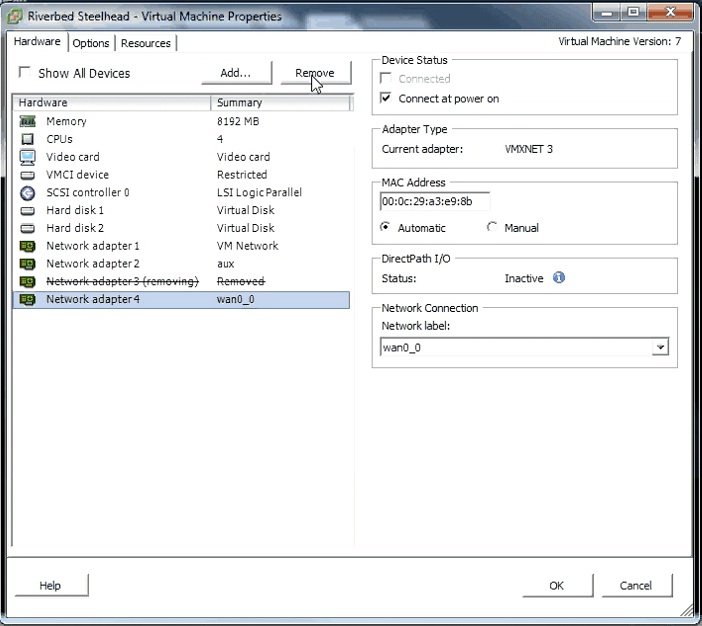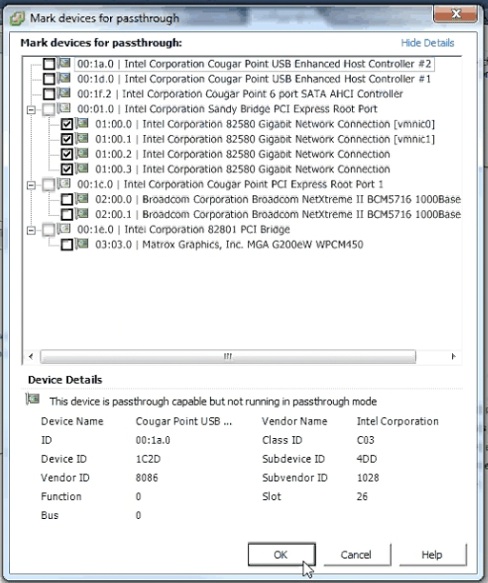Installing NICs in VMware ESXi Hosts for SteelHead Virtual Edition
This chapter describes how to install NICs in VMware ESXi hosts for SteelHead Virtual Edition (SteelHead‑v) appliances. It includes the following sections:
This chapter assumes you have installed and configured the SteelHead-v appliance. For details, see the SteelHead (Virtual Edition) Installation Guide.
The NICs for the SteelHead-v hardware support fail-to-block mode. For more information, see
Fail-to-Block Mode. Note: Physical NICs in SteelHead-v are not supported on Microsoft Hyper-V hosts.
Before You Begin
To successfully install a NIC in an ESXi host for SteelHead-v, you need the following:
• 64-bit ESXi host with a PCIe slot.
• vSphere Client access to the ESXi host.
• VMware ESXi 5.0 or later and RiOS 8.0.3 or later.
—or—
VMware ESXi 4.1 and one of the following RiOS versions:
– For V150, RiOS 7.0.3a or later.
– For V250 and V550 RiOS 7.0.2 or later.
– For VCX555, VCX755, and VCX1555, RiOS 8.0 or later.
For ESXi 4.1, you also need the following:
• ESXi bypass driver (a .VIB file) available from https://support.riverbed.com.
• Intel 82580 Gigabit network interface driver.
By default, ESXi does not include the Intel 82580 Gigabit Ethernet network interface driver needed for the Riverbed bypass card. If you do not have this driver installed, you can download it from the VMware website.
• SSH and SCP access to the ESXi host.
Make sure you follow proper ESD procedures when you handle the NIC:
• Wear properly grounded ESD straps.
• If an ESD strap is not available, touch a properly grounded metallic surface prior to handling the NIC.
• Do not touch the electronic components on the NIC.
NICs for ESXi Hosts for SteelHead-v Appliances
This section describes the software requirements and NIC cards that you can install on ESXi hosts to support SteelHead-v.
Note: Physical NICs in SteelHead-v are not supported on Microsoft Hyper-V hosts.
All the NICs for SteelHead-v support fail-to-block mode. For more information, see
Fail-to-Block Mode. For more information about configuring VMware ESXi, see the SteelHead (Virtual Edition) Installation Guide.
Software Compatibility
SteelHead-v NICs have the following software requirements:
• SteelHead-v xx50 appliances require RiOS 7.0.2 or later.
• SteelHead-v CX555, CX755, and CX1555 appliances require RiOS 8.0 or later.
• SteelHead-v CX5055 and CX7055 appliances require RiOS 8.6 or later.
• VMware ESXi 4.1 requires a driver.
• VMware ESXi 5.0 requires RiOS 8.0.3 or later.
Supported Cards
The following table summarizes the NICs compatible with SteelHead-v appliance.
NICs for SteelHead (virtual edition) | Manufacturing Part # | Orderable Part # | Virtual Appliances |
Two-Port TX Copper Gigabit Ethernet Card | 410-00043-01 | NIC-001-2TX | 150, 250, 550, 555 |
Four-Port TX Copper Gigabit Ethernet Card | 410-00044-01 | NIC-002-4TX | 555, 755, 1555, 5055, 7055 |
Two-Port SR Multimode Fiber 10 Gigabit Ethernet Card (Second Generation) | 410-00302-02 | NIC-008-2SR | 5055, 7055 |
Note: You can install a four-port card in an ESXi host for a SteelHead-v 150, 250, or 550; however, only one port pair will be available because the SteelHead-v model type determines the number of pairs.
Installing NICs in ESXi 5.x Hosts for SteelHead-v
This section describes how to install NICs in ESXi 5.x hosts to provide bypass support using VMware DirectPath with the SteelHead-v.
The maximum number of DirectPath in-path pairs is one (two NICs total) for V150, V250, and V550, and two (four NICs total) for all other virtual appliances.
Note: You must use a Riverbed-branded NIC. SteelHead-v does not support cards not provided by Riverbed. If you currently use a Riverbed-branded NIC with ESXi 4.1, you can use the same card if you want to upgrade the ESXi version; however, you need to reconfigure the card to support the bypass method used in ESXi 5.x.
To install the NIC in an ESXi 5.x host for SteelHead-v
1. Power down the ESXi host.
2. Follow the appliance manufacturer’s instructions for installing a NIC.
You can install the card in any available PCIe slot.
3. Connect the NIC cables.
4. Power up the ESXi host.
To configure the NIC as a pass-through device in an ESXi 5.x host for SteelHead-v
1. In vSphere, shut down the virtual machine.
2. In the Inventory panel, right-click the Riverbed SteelHead VM and choose Edit Settings.
The Virtual Machine Properties window appears.
3. Select the LAN and WAN interfaces and click
Remove.

4. Click OK.
5. In the Inventory panel, select the host for the Riverbed SteelHead VM.
6. In the Configuration tab, select Advanced Settings.
7. Click Configure Passthrough.
8. Select all the NICs corresponding to the Riverbed NIC from the list of available direct path devices.
The NICs are identified as Intel 82580 Gigabit Network Connections.

If a NIC is currently in use, vSphere displays a dialog box prompting you to confirm making this NIC a pass-through device. Click Yes to confirm the change.
9. If you are configuring the 10-G fiber card, select the Broadcom Network Controller as a pass-through device.
The Broadcom Controller might appear as Unknown Controller.
10. Click OK.
The NICs appear in the DirectPath I/O Configuration page as available for direct access by the virtual machines on the host.
11. Reboot the host to apply the changes.
12. Ensure the pass-through devices appear correctly.
In the Inventory panel, select the host from the Configuration tab and click Advanced Settings. Review the devices listed in the DirectPath I/O Configuration.
13. In the Inventory panel, right-click the Riverbed SteelHead VM and choose Edit Settings.
The Virtual Machine Properties window appears.
In this stage, you add the PCI devices to the VM.
14. Click Add.
The Add Hardware dialog box appears.
15. Select PCI Device and click Next.
16. From the Connection menu, choose the PCI device and click Finish.
17. Repeat steps 14 to 16 to add each direct path NIC.
If installing a 10-G fiber card, you also need to add the Broadcom Controller as a PCI device.
18. Power on the virtual machine.
For DirectPath interfaces, speed and duplex values appear in the interface for LAN and WAN.
To verify NIC installation in the ESXi 5.x host
1. From the SteelHead-v CLI, enter the show interface command.
2. In the DirectPath In-Path Interfaces section, confirm the HW Blockable setting is yes.
3. Confirm the Traffic Status is Normal, Bypass, or Disconnect.
4. If the HW Blockable value is no, enter show hardware all and ensure that the card is one of the cards listed below:
2 Port Copper GigE PCI-E Network Bypass Card, 410-00043-01
4 Port Copper GigE PCI-E Network Bypass Card, 410-00044-01
Two-Port SR Multimode Fiber 10 Gigabit Ethernet Card (Second Generation), 410-00302-02
For detailed information about configuring NICs in the SteelHead-v, see the SteelHead (Virtual Edition) Installation Guide.
Installing NICs in ESXi 4.1 Hosts for SteelHead-v
This section describes how to install NICs in ESXi 4.1 hosts for SteelHead-v appliances.
Note: You must use a Riverbed branded NIC. SteelHead-v does not support cards not provided by Riverbed.
To install the NIC in an ESXi 4.1 host for SteelHead-v
1. Download the ESXi bypass driver from https://support.riverbed.com.
2. Enter maintenance mode on the ESXi host.
From the vSphere Client, go to Inventory > Host > Enter Maintenance Mode.
3. Enable remote SSH access on the host.
Using the vSphere Client, select the host and click the Configuration tab. Choose Security Profile > Properties. Select Remote Tech Support (SSH) and click Options. Select a startup policy, click Start and click OK. Ensure the daemon status is running in the Services Properties window.
4. Using SCP, transfer the driver to the host.
For simplicity, Riverbed recommends copying the driver to the /tmp directory. For example, on a Linux system, enter this command:
scp <driver-file>.vib root@<esxi-hostname>:/tmp
Be sure to substitute the actual driver filename and the ESXi hostname.
5. Use SSH to connect to the ESXi host.
For example, from a Linux system log in with this command:
ssh root@<esxi-hostname>
If you cannot log in, ensure that you enabled Remote Tech Support (SSH) and that the host is reachable from your computer.
6. Enter the following command to install the driver:
cd /tmp ; esxupdate -b <driver-file.vib> --nosigcheck update
This command assumes the driver is in the /tmp directory.
7. If necessary, install the Intel 82580 Gigabit network interface driver for the card.
If you do not have this driver installed, you will not see any new vmnic entries in the vSphere Client section for Configuration > Network Adapters once you insert the card and restart the host.
The ReadMe file on the downloaded image contains detailed installation instructions for the driver.
8. Power down the ESXi host.
9. Follow the appliance manufacturer’s instructions for installing a NIC.
You can install the card in any available PCIe slot.
10. Connect the NIC cables.
11. Power up the ESXi host.
12. Disable the Remote Tech Support (SSH) option.
13. Follow the configuration instructions in SteelHead (Virtual Edition) Installation Guide.
14. Check the status lights.
To verify NIC installation in the ESXi host
1. Open vSphere Client and choose Configuration > Network Adapters for the host.
2. Ensure the new NIC (bpvm0) appears in the list of adapters.
3. Verify two or four new vmnic entries appear with MAC addresses starting with 00:0e:b6.
The number of new entries depends on the number of ports of the card. All Riverbed MAC addresses start with the 00:0e:b6 corporate identifier.
For detailed information about configuring NICs in the SteelHead-v, see the SteelHead (Virtual Edition) Installation Guide.
Identifying Interface Names in SteelHead-v Appliances
The interface names for the NICs in the SteelHead Management Console and the CLI are a combination of the slot number and the port pairs (lan<slot>_<pair>, wan<slot>_<pair>). For example, if a four-port NIC is located in slot 0 of your appliance, the interface names are lan0_0, wan0_0, lan0_1, and wan0_1 respectively.
The SteelHead-v model determines the maximum number of hardware bypass pairs.
• V150, V250, and V550 appliances support one bypass pair (one LAN and one WAN port)
• VCX555, VCX755, VCX1555, VCX5055, and VCX7055 appliances support two bypass pairs (two LAN and two WAN ports)



